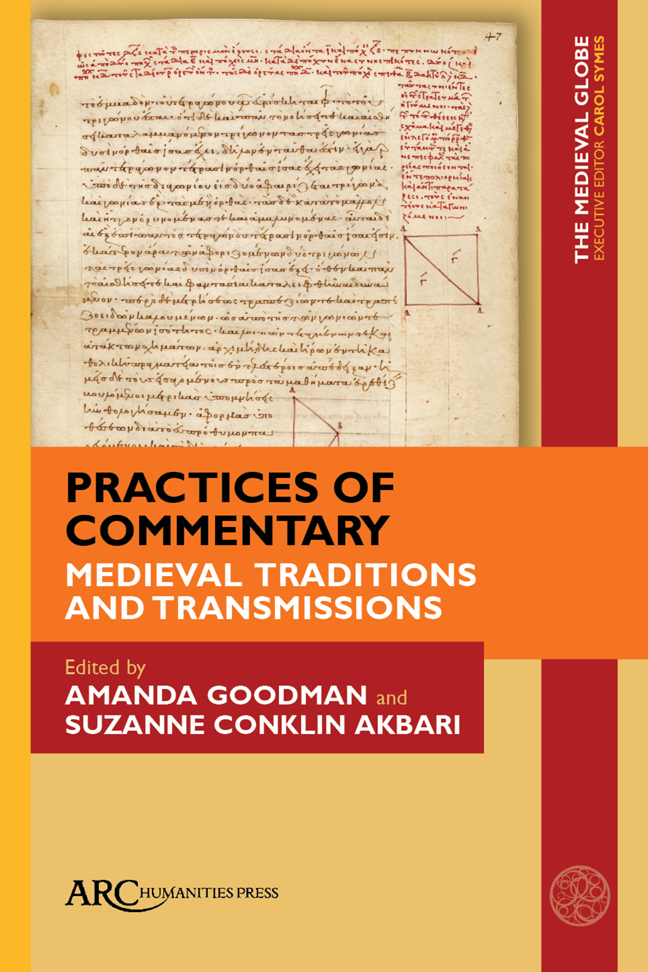Book contents
- Frontmatter
- Contents
- List of Illustrations
- Introduction: Commentary at the Crossroads
- Graeco-Roman Commentary Beyond Alexandria: Problems and Prospects
- From Plane to Space: The Narrative Arc of a Byzantine Mathematical Manual
- Periodization in the Sunni Qur'an Commentary Tradition: A Chronological History of a Genre
- On the Practice of Autocommentary in Sanskrit Sources
- Oral Commentaries and Scholarly Debates in Sanskrit Philosophy
- On the Nature of Chinese Buddhist Scriptural Exegesis: Observations on the Commentaries of Chengguan, Woncheuk, and Other Sui-Tang Exegetes
- The Mise-En-Page of a Sino-Tibetan Dunhuang Manuscript: Yuanhui's Commentary on the Laṅkāvatārasūtra
- Commentary and Multilingualism in the Ottoman Reception of Texts: Three Perspectives
- Index
On the Practice of Autocommentary in Sanskrit Sources
Published online by Cambridge University Press: 17 February 2024
- Frontmatter
- Contents
- List of Illustrations
- Introduction: Commentary at the Crossroads
- Graeco-Roman Commentary Beyond Alexandria: Problems and Prospects
- From Plane to Space: The Narrative Arc of a Byzantine Mathematical Manual
- Periodization in the Sunni Qur'an Commentary Tradition: A Chronological History of a Genre
- On the Practice of Autocommentary in Sanskrit Sources
- Oral Commentaries and Scholarly Debates in Sanskrit Philosophy
- On the Nature of Chinese Buddhist Scriptural Exegesis: Observations on the Commentaries of Chengguan, Woncheuk, and Other Sui-Tang Exegetes
- The Mise-En-Page of a Sino-Tibetan Dunhuang Manuscript: Yuanhui's Commentary on the Laṅkāvatārasūtra
- Commentary and Multilingualism in the Ottoman Reception of Texts: Three Perspectives
- Index
Summary
COMMENTARIES HAVE PLAYED a crucial role in the development of South Asia's religious and intellectual history. Although many are lost, they have come down to us in impressive numbers; they are sometimes said to constitute up to three-quarters of the Sanskrit written tradition. They explain texts of an astounding variety, including scriptures, poetry, and treatises bearing on a wide array of topics, from grammar to veterinary science, and many a commentary (or subcommentary) had a more consid-erable impact than independent works. These facts are certainly to be understood in relation to the presupposition, prevalent among Sanskrit writers, that an assertion unsanctioned by antiquity is suspicious; and to their efforts to present innovations as mere expressions of an eternal truth handed down by an immemorial tradition. Even authors of independent works often presented themselves as mere exegetes of more ancient formulations, and many commentators tended to disguise their own novel ideas as mere clarifications of the text on which they were commenting. This “novelty- smuggling strategy” was often implemented by distinguishing an obvious but super-ficial meaning from a hidden, more profound one that they claimed to uncover, and by inventing various hermeneutical devices so as to force into the texts that they were supposed to explain some ideas that were blatantly alien to them. Numerous Sanskrit words designate these commentarial works, but much research remains to be done before we can understand the fluctuating history of these terms and their changing meanings according to the tradition in which they were used.
The present essay is not concerned with this complex history of Indian commentar-ies and their names, but only with the intriguing phenomenon of “self-commentaries” or “auto(-)commentaries.” Both terms, while conspicuously absent from the English dictionaries that I could consult, are widely used nowadays in secondary literature, the former being favoured in research on Western works whereas the latter is com-mon in South Asian studies. In Sanskrit, such texts are usually designated by prefixing sva- (“self-”/“auto-”) or svopajña- (“self-invented”) to one of the numerous terms used to denote commentaries. The practice of composing commentaries to explain one's own works was widespread among Sanskrit-writing authors; yet it remains hardly studied to date.
- Type
- Chapter
- Information
- Practices of CommentaryMedieval Traditions and Transmissions, pp. 65 - 90Publisher: Amsterdam University PressPrint publication year: 2023



